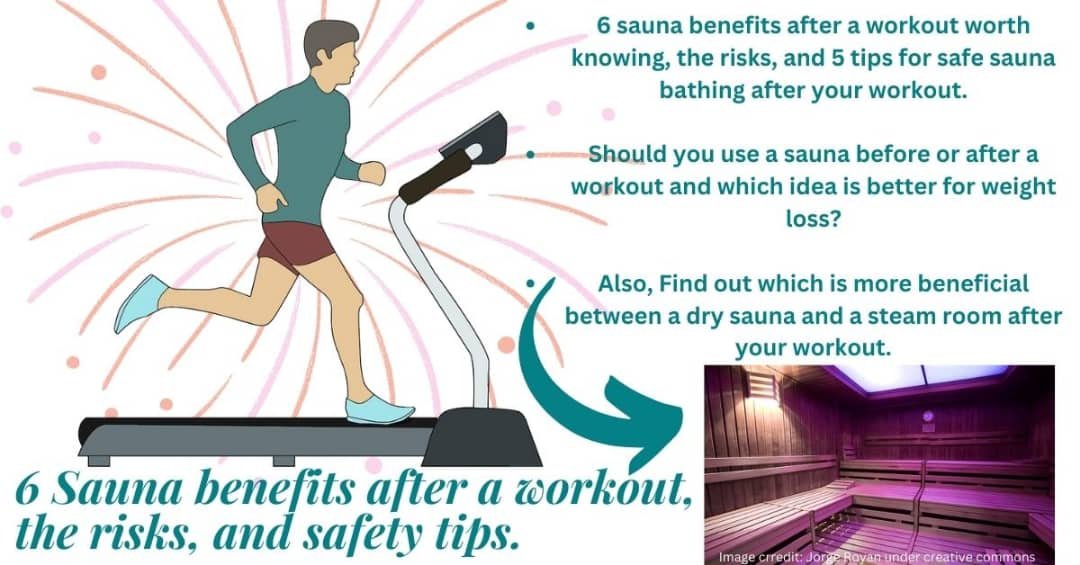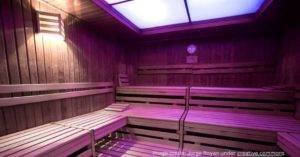
Table of Contents
Post-workout sauna bathing involves exposing your body to temperatures that may range from 45 to 100° C (113 – 212° F) or slightly more, for at least 5 minutes or way more after you are done with your exercises. This has been scientifically proven to enhance your recovery and reduce muscle soreness among other benefits. However, you are advised never to exceed 20 to 30 minutes in a sauna, especially after a workout.
In an earlier article, I listed several health benefits you get from the use of saunas. You’ll find most of the benefits you get from using saunas are similar to what you get from your workout sessions. So you may ask, why do I have to still get into saunas after a workout?
In this article, I will discuss the added advantage of using saunas after your workouts and why you should give it a try. You will also learn how to use a sauna properly post-workout, why you should avoid certain behaviors, and the risks you are exposed to by using it the wrong way.
The risks and health benefits of sauna after workout.
A lot is been said about what you could benefit from having a sauna bath most of which stresses muscle growth. Research conducted on this subject by Northern Michigan University (NMU) found this to be incorrect.1 It was a 6-week research involving 13 young males who were mostly between the ages of 19 years to 23 years.
The subjects did resistance training during the period of the research in addition to 3 sauna sessions of 15 minutes per week. At the end of the research, it was found that the use of saunas in addition to resistant training didn’t result in the expected increase in muscle strength and hypertrophy.
Notwithstanding, sauna use has been shown to cause a transient increase in growth hormone levels by as much as 142% but it returns to normal levels within an hour as per research published in Europe PubMed Central.2 This short-term increment may have a role to play in enhancing muscle strength and bulk but is ineffective as a stand-alone measure as suggested in the study described here.
This does not mean there are no real benefits to using saunas after your workouts. Even if sauna bathing doesn’t result in significant muscle growth, it may help in the maintenance of skeletal muscles. This should explain why they help fight sarcopenia.
Below are some scientifically proven reasons for sauna bathing after exercise.
6 Benefits.
1. Facilitation and quickening of post-workout recovery: This is one of the major reasons for post-workout sauna use. Research has found it makes muscle recovery easier and faster after exercises. The heat from saunas dilates blood vessels and increases heart rate.
By this, they boost the supply of oxygen and nutrient-rich to vital organs and muscles plus the removal of metabolic wastes. The combination of these outcomes from the use of saunas results in quicker recovery, healing, and reduction of soreness after workouts.
In one study involving 16 male basketball players, infrared sauna use after exercise was found to reduce post-workout muscle soreness, improve quality of recovery, and reduce recovery time without any detrimental effect on the recovery of their autonomic nervous system as published in the Journal of Biology of Sports.3
2. Relaxation and destressing: Saunas are known for their relaxing effect after stressful workouts. The application of heat eases muscle tension and stiffness. The relaxation effect of sauna use is a reason some people think you shouldn’t use them before exercises to avoid workout injuries but this is not quite correct for the most part.
On the contrary, it has the opposite effect and reduces your risk of injury as I’ll discuss later but pre-workout sauna bathing shouldn’t be mistaken for a pre-workout warm-up let alone substitute the traditional active pre-workout warm-up.
3. Increase in muscle endurance and performance: Research has found post-exercise use of infrared saunas to reduce the expected drop in performance of athletes after undergoing resistance training.
4. Boosting blood circulation: A physiological effect of heat application on the body is vasodilation(widening of the lumen) of blood vessels. This, in addition to an increase in heart rate from sauna bathing, ensures a commensurate increase in blood circulation.
5. Reduction in inflammation: In one study, published in the European Journal of Epidemiology, 2,084 men between the ages of 42 – 60 years were subjects in finding out the relationship between C-reactive proteins and sauna bathing.4 C-reactive proteins are known markers of inflammation and serve as guides in studying inflammation in disease conditions and can be part of the blood tests in detecting psoriasis arthritis.
The subjects were divided into 3 classes according to the frequency of their use of sauna per week. About a quarter have sauna once a week, more than half have it 2 to 3 times weekly while less than 10% get into saunas as much as 4 to 7 times weekly.
At the end of the experiment, it was found that the frequency of sauna use is inversely proportional to the levels of C-reactive proteins detected in their blood. This outcome suggests the use of sauna may have anti-inflammatory benefits.
6. Reduced risk of post-workout respiratory distress: Stress is a well-known trigger of asthmatic symptoms in people with the condition and workouts can be stressful. A wet sauna or steam room reduces airway congestion, tidal volume, vital capacity, and general lung function. This may be good for asthmatic patients in reducing the risk of an exacerbation post-workout according to the American Journal of Medicine.5
2 main risks.
With all you stand to benefit from post-workout sauna, there are risks to the use of these saunas as I listed in another article. Of those risks, two of them can be associated with using a sauna after your workout.
1. Increased risk of dehydration: You may lose a considerable amount of water from sweating during workouts. Saunas represent an extra avenue to sweat more. This places you at increased risk of dehydration when used after workouts. Drinking water after your exercise before going for sauna bathing is the way to go.
2. Stressed-out heart: Although saunas are beneficial for people with some type of heart disease, they place some level of stress on your heart during usage. There are heart conditions that demand limiting the intensity and duration of the stress you place on your heart. For this reason, you will need to consult your healthcare provider before using a sauna, especially in addition to exercises.
Kindly keep in touch by signing up for our newsletter:
5 tips on how to use a sauna after a workout.
As we’ve mentioned earlier, there are many benefits to the use of saunas after workouts, however, there are risks too. Below are a few tips to observe to enable you to safely enjoy your sauna post-exercise.
1. Get hydrated: Dehydration is a major risk to the use of a sauna after your workout. To avoid this, you should first rehydrate after your exercise by taking 2 or 3 glasses of water, before getting into the sauna. You may also take some water during sauna bathing to keep you hydrated.
2. Keep it short: Knowing that sauna bathing has a very similar effect on the body as workouts, Keeping it shorter than you would have if you hadn’t had a workout helps you avoid overdoing it including reducing your risk of dehydration and hyperthermia.
3. Avoid alcohol: Alcohol consumption is responsible for some tragic events in saunas. It increases your risk of cardiac arrhythmia, sudden death, and hypotension. Stay away from it if you must use a sauna, especially after a workout. Don’t also use it for hydration, it’s not meant for that job and will be counterproductive.
4. Start at lower temperatures and go easy: If you are new to post-workout sauna bathing, you should begin with lower temperatures and build on that as your body acclimatizes,
5. Be guided by listening to your body: Always pay attention to your body while in the sauna. Once there are signs of symptoms like muscle cramps, dizziness, or lightheadedness, understand your body can no longer cope with the heat.
How long to stay in the sauna after a workout?
A normal duration of sauna bathing is 15 to 20 minutes but it may be safer for newbies to start from 5 to 10 minutes as I stated in a related article.
If you have been a regular user of saunas without workouts, or are used to having it before workouts, you can be sure your body has acclimatized to that routine. However, if you now want to try out sauna bathing after workouts, you may find it safer to revert to the 5 to 10-minute duration and build from that as you get used to it.
The reason is that sauna bathing after workouts is more taxing on the body that has already gone through the rigors of exercise. It feels like going an extra mile from what you are used to so you’ll need to give your body time to adjust to the more extreme measure before increasing the length of your sauna sessions.
Sauna before and after a workout.
If you are already used to sauna bathing before and after workouts that’s fine but if it’s something you want to start for the first time, you’ll need to be careful because it has increased risks.
There is a reason someone may want to get into a sauna before and after a workout but what is yours? An asthmatic patient or someone with some kind of nasal congestion may benefit from a wet sauna or steam room before a workout. It will help to boost lung function and reduce the risk of respiratory distress induced by the workout.
Pre-workout sauna bathing improves blood circulation around your body which may help prepare you for the workout but it shouldn’t be confused with warm-up exercises or replace them. Warm-ups must involve actual movements and stretches that activate the muscles of your body in preparation for exercises. The physically inactive mode you assume during sauna bathing can’t achieve this.
If warming up is the sole reason you do pre-workout sauna bathing you now have reason to think twice about it. Your muscles aren’t getting activated in a passive sauna so don’t see it as an alternative to the light physical activities you do during warm-ups.
Nevertheless, pre-workout sauna bathing can contribute to your warm-up measures but shouldn’t replace the stretches and light exercises that activate the muscles you recruit for your workouts.
I came across a statement that suggested sauna bathing before an exercise leaves you at risk of injury during workouts because it relaxes your muscles. There are three scenarios I can think of that can lead to injuries during workouts and sauna bathing isn’t one of them. These are:
- Not engaging in pre-workout warm-ups to activate your muscles.
- Starting a workout with already tense muscles.
- Engaging in unusual exercises, levels of stress, or introduction of resistance weights that are way above what your muscles can cope with.
Muscles work more efficiently when they are relaxed against being tensed up and this is part of what stretches aim to achieve before workouts. Those stretches relax the muscles way better than what you can expect to achieve by sitting passively in a sauna.
A notable danger in having sauna bathing before and after workouts is that it could triple your risk of dehydration. Dehydration places you at risk of muscle cramps during workouts in addition to lightheadedness.
A downside to sauna use before a workout is the cardiovascular and metabolic responses it triggers. These physiological impacts of sauna bathing may leave some people feeling less energetic for their workout. Approaching your workout session with lethargy after sauna bathing can make you do less and with less vigor, thereby reducing the benefits you can get from the workout. This is a disadvantage of a pre-workout sauna.
A post-workout sauna can be more beneficial than the pre-workout and I do opt for it if I have to choose between the two. It helps you recover faster and better from the workout among other benefits. I made a comparison between the dry sauna and wet sauna (steam room) in another article to highlight which of the two is better after a workout.
Sauna before or after a workout to lose weight.
If you glance through my last two paragraphs above, you will already have an answer to this subtopic. As a result of the lethargy pre-workout sauna can create due to the physiological impact, you may not approach your workout with the kind of vigor and energy you ordinarily would.
This can reduce the benefits you stand to derive from your workout which may translate to burning fewer calories. Saunas are ineffective as a tool for weight loss but can contribute to your overall weight loss drive. A sauna session may not see you burn through more than 70 calories.
Most of the calories you burn happen during your workout. Where pre-workout sauna leaves you feeling less energetic for your workout it can become counterproductive towards your weight loss goal.
The amount of calories you burn in a sauna doing nothing should correspond to the temperature and length of your sauna session which ideally lies between 15 to 20 minutes. In other words, you burn roughly the same amount of calories from a sauna used before or after a workout. Neither of the options makes you burn more calories but one can make you burn fewer calories during your workout.
To this end, sauna bathing after a workout should serve your weight loss interests better than before a workout. This is because of the impact of a pre-workout sauna bathing on your energy level, as mentioned earlier.
Sauna or steam room after a workout.

Both types of facilities essentially trigger similar physiological reactions and achieve relatively the same health benefits. However, because of their sources of heat, some differences will make one preferable or better suited than the other after a workout.
The most suitable of the two will depend on your interests, feelings, and health needs. If you have nasal congestion, asthma, or suffering from an obstructive pulmonary disease, a steam room will be better for you. I gave more details and instances of when a dry sauna could be preferred in another article you may want to look up. There, I concluded which of the two is better on a general note.
Sauna after running or cardio.
Running is one of the most serious forms of cardio and can ramp up your heart rate toward the maximum heart rate. However, not all cardio is as physically exerting as running. What makes the difference is the intensity with which you exercise.
High-intensity exercises like running will more likely result in muscle soreness for which you could need a sauna. However, with the level of physical exertion and sweating involved in running, it will be wise to transition to low-intensity drills as a way of cooling down plus taking a couple of glasses of water before heading into a sauna.
Generally, you may want to go through a warm-up phase before commencing cardio and then a cool-down phase afterward before entering a sauna. Some people may want to have a sauna before commencing warm-up in preparation for cardio. However, you have to start your cool-down phase outside a sauna.
That’s it on this topic and I hope it was helpful. I’ll be looking forward to your questions, see you on the next one.
Reference
- Jones, Brandon C. Mr., “The Effect of Hyperthermic Whole Body Heat Stimulus (Sauna) on Heat Shock Protein 70 and Skeletal Muscle Hypertrophy in Young Males during Weight Training” (2017). All NMU Master’s Theses. 151. https://commons.nmu.edu/theses/151 ↩︎
- Lammintausta R, Syvälahti E, Pekkarinen A. Change in hormones reflecting sympathetic activity in the Finnish sauna. Annals of Clinical Research. 1976 Aug;8(4):266-271. PMID: 999213. ↩︎
- Ahokas, E., Ihalainen, J. K., Hanstock, H., Savolainen, E., & Kyröläinen, H. (2023). A post-exercise infrared sauna session improves recovery of neuromuscular performance and muscle soreness after resistance exercise training. Biology of Sport, 40(3), 681-689. https://doi.org/10.5114/biolsport.2023.119289 ↩︎
- Laukkanen, J.A., Laukkanen, T. Sauna bathing and systemic inflammation. Eur J Epidemiol 33, 351–353 (2018). https://doi.org/10.1007/s10654-017-0335-y ↩︎
- Hannuksela, M. L., & Ellahham, S. (2001). Benefits and risks of sauna bathing. The American Journal of Medicine, 110(2), 118-126. https://doi.org/10.1016/S0002-9343(00)00671-9 ↩︎































































































































































Very nice info and straight to the point. I am not sure if this is really the best place to ask but do you folks have any thoughts on where to get some professional writers? Thanks 🙂
Woh I like your blog posts, saved to bookmarks! .
I have not checked in here for some time. The last several posts are good quality. I’ll add you to my daily bloglist. You deserve it my friend 🙂